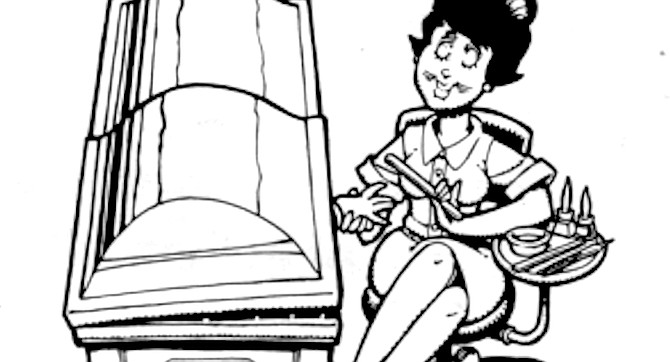 Facebook
Facebook
 X
X
 Instagram
Instagram
 TikTok
TikTok
 Youtube
Youtube

Dear Matthew Alice: My co-worker and I are having a friendly discussion. It’s my understanding that after a person dies, their hair and nails continue to grow, at least for a short time. My co-worker insists this is impossible. Please help me make him understand how ignorant he is about this scientifically observed fact. — Mario Lopez, La Mesa
Memo to: Mario’s co-worker. From: M. Alice, Re: Arguing with Mario. Dear Co-worker: When Mario tosses around words like “scientifically observed fact,” I suggest you ask him to produce the scientists. I also recommend wagering large sums of money on the outcome of any future disputes. A few more “friendly discussions” like this one, and the kids’ college tuition worries are over.
Setting aside any legal and ethical problems we've had defining death in the first place, it is true that lots of things are going on in the body when it finally bites it. But nothing that would particularly interest a cosmetologist. Without normal blood circulation and brain activity, the fluid contents of cells and organs (dissolved mineral salts, hormones) seep into the bloodstream and body cavities. Digestive enzymes start dissolving the stomach and small intestine then leak into the abdominal cavity and digest other body parts until the enzymes finally break down chemically. And though the host may be dead, the body’s bacteria live on and consume tissue, unchecked by natural defenses.
Aside from bacteria, the only parts of a corpse that do not cease normal functioning immediately are muscle cells. They retain enough chemical vigor to react to electrical stimulation as they would to stimulation from the brain. Apply a jolt of juice to, say, an arm muscle and it will contract. But this funeral parlor trick can be performed for only an hour or so, until rigor mortis begins to set in. And forget those stories of rigor mortis causing corpses suddenly to sit up and scare the bejeezus out of the mourners. Rigor mortis is a hardening of muscle tissue, not a contraction.
All this chemical and bacterial activity blows the body up like a balloon for the first day or so, until the skin begins to dry and shrink. And it’s here that most contemporary scientists believe the old stories of hair and nails “growing” come from. When the skin retracts from the hair root and nail bed, nails and hair shafts appear longer, but they haven’t actually grown. When you consider that under the best metabolic circumstances, scalp hair grows at a rate of one inch every two months and fingernails grow even more slowly, the corpse would have to retain its hair-growth capability for more than two weeks to lengthen even a quarter of an inch.
So that’s death in a nutshell. A biochemical and bacterial fiesta, for the most part. Your hairdo and manicure remain intact. Tell Mario I said hi.


Dear Matthew Alice: My co-worker and I are having a friendly discussion. It’s my understanding that after a person dies, their hair and nails continue to grow, at least for a short time. My co-worker insists this is impossible. Please help me make him understand how ignorant he is about this scientifically observed fact. — Mario Lopez, La Mesa
Memo to: Mario’s co-worker. From: M. Alice, Re: Arguing with Mario. Dear Co-worker: When Mario tosses around words like “scientifically observed fact,” I suggest you ask him to produce the scientists. I also recommend wagering large sums of money on the outcome of any future disputes. A few more “friendly discussions” like this one, and the kids’ college tuition worries are over.
Setting aside any legal and ethical problems we've had defining death in the first place, it is true that lots of things are going on in the body when it finally bites it. But nothing that would particularly interest a cosmetologist. Without normal blood circulation and brain activity, the fluid contents of cells and organs (dissolved mineral salts, hormones) seep into the bloodstream and body cavities. Digestive enzymes start dissolving the stomach and small intestine then leak into the abdominal cavity and digest other body parts until the enzymes finally break down chemically. And though the host may be dead, the body’s bacteria live on and consume tissue, unchecked by natural defenses.
Aside from bacteria, the only parts of a corpse that do not cease normal functioning immediately are muscle cells. They retain enough chemical vigor to react to electrical stimulation as they would to stimulation from the brain. Apply a jolt of juice to, say, an arm muscle and it will contract. But this funeral parlor trick can be performed for only an hour or so, until rigor mortis begins to set in. And forget those stories of rigor mortis causing corpses suddenly to sit up and scare the bejeezus out of the mourners. Rigor mortis is a hardening of muscle tissue, not a contraction.
All this chemical and bacterial activity blows the body up like a balloon for the first day or so, until the skin begins to dry and shrink. And it’s here that most contemporary scientists believe the old stories of hair and nails “growing” come from. When the skin retracts from the hair root and nail bed, nails and hair shafts appear longer, but they haven’t actually grown. When you consider that under the best metabolic circumstances, scalp hair grows at a rate of one inch every two months and fingernails grow even more slowly, the corpse would have to retain its hair-growth capability for more than two weeks to lengthen even a quarter of an inch.
So that’s death in a nutshell. A biochemical and bacterial fiesta, for the most part. Your hairdo and manicure remain intact. Tell Mario I said hi.
Comments